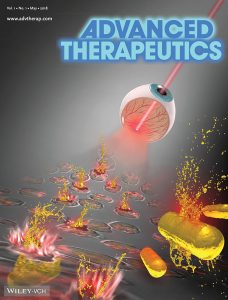I am thrilled to announce that my master student Megan Pulford was selected for a Dave Marshall Leadership Award in the Academic category!

I am thrilled to announce that my master student Megan Pulford was selected for a Dave Marshall Leadership Award in the Academic category!
I’m pleased to announce that the PHYS 3016, Sensors, course is now available to take for all student with course prerequisite of any 15 credits. Sensors are used in a variety of applications in industry, environment, and medicine. During this course students learn basic characteristics of sensors and how to classify them into different categories such as thermal, electrical, magnetic, optical, mechanical, and chemical. Students work on solving a problem by proposing a sensor system and learn how to define the sensors’ performance criteria and interpret output data.
I’m pleased to announce that the PHYS 2016, Biophotonics, course is now available to take for all student with course prerequisite of any 15 credits. During this course Students explore the principles of light interaction with biological systems and specific biomedical applications of photonics. The course covers basic principles of light, fundamentals of light sources, light tissue interaction, optical fiber, microscopy, optical probes, biosensors, optical image procedures, and applications of nanotechnology and nanomaterial in biology and medicine.
I am pleased to announce that my undergraduate research student , Megan Pulford, have been selected to move forward with her Research Training Award (RTA) application. The RTA is an opportunity for undergraduate and graduate students to undertake a 12-16-week paid internship ($6,000 per student) during Fall 2020.
Megan’s projet is “Study of palsmonic nanostructures for enhanced solar energy harvesting”.
We had a chance to collaborate on a joint project titled, “Anti-EPCAM Gold Nanorods and Femtosecond Laser Pulses for Targeted Treatment of Retinoblastoma” with the Department of Electrical and Computer Engineering and Department of Oncology in University of Alberta.Retinoblastoma is a cancerous disease that affects the retina, and primarily affects young children.
This work presents a new technique to treat retinoblastoma cancer that ties physics, biology and computational modellingusing gold nanorods and femtosecond laser pulses. Femtosecond laser pulses are delivered through the various components of the eye, and absorbed by the gold nanorods. Once the gold nanorods absorb the laser light pulse, they heat up and explode inside the cancer cells, leading to targeted destruction of retinoblastoma cells. The report on this project was accepted as is in the Advanced Therapeutics Journal and has been chosen to appear on cover.
I am pleased to welcome Arezou Rashidi who joined us on early march 2018 as Visiting PhD Research Student. Arezou is fourth year Ph.D. student in the field of Computational Nanophotonics in Physics Department at the University of Tabriz, Iran. She was recognized as a top student (1st rank) during her B.Sc. and M.Sc. In 2008, Arezou was awarded as National Exceptional Talent in Physics from University of Tabriz and since then she has been a member of National Exceptional Talent Club. Her current research projects are focused on Photonic Crystals and Graphene-Based Nanostructures. So far she has published several papers in different journals such as Superlattices and Microstructures, Applied Optics and The European Physical Journal B.
A figure from our published paper has been chosen to appear on cover 1 of the 14 August 2017 issue of Journal of Applied Physics. This paper was with the collaboration of Nanophotonics and Quantum Devices Group at The University of Alabama in Huntsville. “Optically saturated and unsaturated collective resonances of flat metallic nanoantenna arrays”, Journal of Applied Physics,122, 063102 (2017).
SPIE Nanoscience + Engineering – 9 August 2017 – San Diego, California United States
Title: “Tunable coupling between exciton-polariton and exciton-surface plasmon in hybrid systems consisting of VO2 nanoparticles and quantum dots”
Abstract: Vanadium dioxide (VO2) features a semiconductor to metal phase change characteristic that leads to an abrupt change in the particle’s optical properties. A hybrid system consisting of semiconductor quantum dot (SQD) and vanadium dioxide nanoparticle (VO2NP) can support the coherent coupling of exciton-polaritons and exciton-plasmon polaritons in the semiconductor and metal phases of the VO2NP, respectively. In this talk, we theoretically show that the controlling over the VO2NP phase change transition alters the SQD optical response drastically in comparison to a bare SQD. The results can be applied to the design of thermal sensors at the nanoscale.
Math Talk Series – 28 May, 2017 – 1:15pm to 2:30pm in room A129.Title: “Quantum Dot Nanophotonics”
Abstract: Quantum dots (QDs), known as artificial atoms, are nanoscale semiconductor materials with a unique size-tunable optical property. These unique size dependent qualities lead to a narrow photoluminescence spectrum in the range of visible to infrared light. QDs have attracted tremendous attention in the past few years for a variety of scientific and commercial applications such as biological sensors, quantum commuting, photovoltaic and light emitting devices. In this talk we present a brief description of QDs and their associated optical properties,highlighting the concept the size dependent photo-physical properties. We also show how the coupling of QDs with the other nanostructures can dramatically alter the QDs photoluminescence for further development of QDs for each respective application.